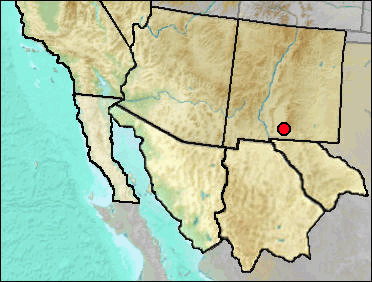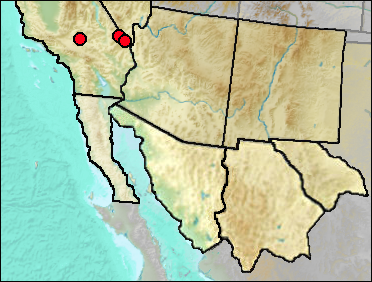Class Mammalia
Order Rodentia
Family Sciuridae
Spermophile Ground Squirrels—Spermophile Ground Squirrels // Callospermophilus lateralis—Golden-mantled Ground Squirrel // Ictidomys/Xerospermophilus)—Ictidomys or Xerospermophilus Ground Squirrel // Ictidomys tridecemlineatus—Thirteen-lined Ground Squirrel // Otospermophilus bensoni—Benson Rock Squirrel // Otospermophilus variegatus—Rock Squirrel // "Spermophilus" cochisei—Cochise Ground Squirrel // Urocitellus elegans—Wyoming Ground Squirrel // Urocitellus townsendii—Piute Ground Squirrel // Xerospermophilus spilosoma—Spotted Ground Squirrel

Synonyms. Spermophilus elegans, S. richardsonii.
A partial maxilla and palatine from Pendejo Cave is consistent with U. elegans, but not diagnostic.
Sites.
Mid Wisconsin: Pendejo Cave (Harris 2003).
Literature. Harris 2003.

Synonyms. Spermophilus elegans, S. richardsonii. The taxon earlier known as S. richardsonii has been recognized as consisting of two species; the more southerly takes the name U. elegans and the more northern now is U. richardsonii, and records in our area are assumed to belong to U. elegans.
The current geographic range is to the north, with the extreme southern limits reaching barely into central Colorado. However, remains have been recovered in an archaeological context (early 14th to early 15th centuries) near Santa Fe (Lang and Harris 1984), suggesting that some factor other than climate has caused their extirpation from the south. One possibility lies in the changes and losses in low vegetation following introduction of stock into the Southwest—especially sheep and goats.
Zegers (1984) noted from the literature that U. elegans inhabits sage plains and grassland habitats from valley bottoms to subalpine talus slopes. This fits well with the hypothesized presence of sagebrush grasslands in southern New Mexico during late glacial times.
Sites.
Mid/Late Wisconsin: Dark Canyon Cave (Tebedge 1988: cf.).
Late Wisconsin: Animal Fair 18-20 ka (Harris 1989); Balcony Room (UTEP); Charlies Parlor (Harris 1993c: cf.); Harris' Pocket (Harris 1989) Sheep Camp Shelter (Gillespie 1985: cf.).
Literature. Gillespie 1985; Harris 1989, 1993c; Lang and Harris 1984; Tebedge 1988; Zegers 1984.

Synonyms. Spermophilus townsendii.
Discussion. Nomenclatural changes within the genus Spermophilus have resulted in a number of differences (Helgen et al. 2009) since the appearance of most publications reporting fossil ground squirrels from our region. Urocitellus townsendii currently is limited to a small area in southeastern Washington; U. mollis is a more likely species based on modern distribution; however,the identification given in Jefferson (1991b) is retained for the time being.
Sites.
Rancholabrean: Hoffman Road (Jefferson 2014: ?); Piute Valley (Jefferson 1991b).
Late Wisconsin/Holocene: Kokoweef Cave (Reynolds, Reynolds, et al. 1991).
Literature. Jefferson 1991b, 2014; Helgen et al. 1009; Reynolds, Reynolds, et al. 1991.
Last Update: 17 May 2015